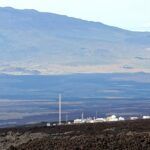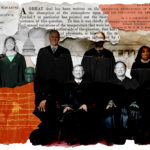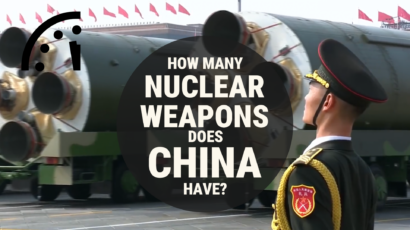Nuclear vs. renewables: Divided they fall
By Dawn Stover | January 30, 2014
People who agree that climate change is a dire problem often disagree about how to solve it. In recent months, once-private disagreements have ballooned into a public spat between pro-nuclear and anti-nuclear climate activists. Depending on whom you ask, nuclear power is either “essential” or “ill-suited” to efforts aimed at staving off climate disaster.
Nuclear power and renewable energy sources (including solar, wind, biofuels, geothermal, and hydropower) make comparable contributions to US energy, and both are dwarfed by fossil fuels: According to the US Energy Information Administration, in 2012 nuclear and renewables each provided between 8 and 9 percent of all energy used in the United States. Petroleum, natural gas, and coal together provided 81 percent.
You would think, then, that the little guys would realize they only stood a chance if they teamed up against Goliath. Instead, advocates for nuclear and renewables are doing just the opposite: They’re competing with each other for government favors and bickering over the question of what should replace fossil fuels, at times framing the debate as an either-or choice. Although both sides acknowledge the magnitude of the climate crisis, they stubbornly refuse to grow up and face the facts: Even with huge expansions of both nuclear and renewables, keeping global warming below a dangerous level will be a tough order.
It must be entertaining for fossil-fuel lobbyists to watch from the sidelines as their puny adversaries sling rocks at each other. But for climate campaigners, being divided and conquered is the worst possible game plan. If they don’t all learn to get along, and soon, it’s game over for climate policy.
War of words. The opening salvo in the latest battle came from the pro-nuclear camp. Four of the nation’s most prominent climate and energy scientists—James Hansen (a member of the Bulletin’s Science and Security Board), Ken Caldeira, Kerry Emanuel, and Tom Wigley—in November 2013 issued an open letter “to those influencing environmental policy but opposed to nuclear power” in which they urged the development and deployment of “safer nuclear energy systems.” They noted that renewables would play a role in the future energy economy but wrote: “in the real world there is no credible path to climate stabilization that does not include a substantial role for nuclear power.” They conceded that “no energy system is without downsides,” and argued for innovations to make nuclear energy safer and cheaper.
A January 6 rebuttal, spearheaded by the Civil Society Institute and the Nuclear Information and Resource Service (NIRS)—and signed by more than 300 people affiliated with environmental and peace groups, including some affected by the Fukushima disaster in Japan—chastised Hansen and his colleagues for supporting nuclear power. The rebuttal letter argued instead for wind and solar power, increased energy efficiency, demand management (for example, incentives to use less electricity during peak hours), and new energy-storage technologies. NIRS president Michael Mariotte said he and his colleagues were taking issue with “the mistaken idea that nuclear power is some kind of panacea for all that ails our climate.”
The “panacea” accusation seems overblown, especially coming from a coalition arguing that wind and solar power alone will be sufficient to meet future energy demands. Moreover, a closer examination of the arguments on both sides reveals that they actually have a lot in common.
For example, both sides make the case that their technology is economical, but in fact neither can easily compete against fossil fuels without help from the government. Without tax credits and renewable energy mandates, construction of wind turbines and solar panels would grind to a halt. And without government liability protection and public subsidies to attract private capital, the nuclear industry would be sunk.
Both sides go astray when they base their arguments on unproven, un-deployed technology. “Safer” nuclear power, for example, exists only on paper at the moment. And making wind turbines and solar panels the mainstay of US power generation would require a massive expansion of the electricity grid, as well as not-there-yet storage technologies.
Common ground. Media outlets have reported the schism between nuclear and renewables as if it’s a sporting contest, play by play. But the planet’s fate is no game, and polarized politicians don’t make good role models for adult behavior. If climate activists are to have any hope of real progress in the policy arena, they must present a united front. There are plenty of policies they can jointly support: the elimination of tax privileges for fossil fuels, stricter rules for mining and fracking, a massive ramp-up in requirements and support for energy efficiency and conservation, and a carbon tax that would force polluters to pay for the damage they do to the environment and human health.
At the moment, renewables have the upper hand in the nuclear-versus-renewables fracas, partly because nuclear proponents have failed to come to terms with issues of safety, security, and waste disposal. Accidents and security breaches will never be entirely preventable, and there is no plan on the horizon for dealing with waste. The US nuclear industry must resolve the last issue immediately, in order to have any credibility in the future. For its part, the renewables industry must understand that resisting all attempts at creating a nuclear waste repository only ensures that the fossil fuel industry will continue to pump more of its harmful wastes into the atmosphere.
In Germany, the renewables-only approach that will phase out nuclear power by 2022 drove coal consumption to a new high in 2013. Relying exclusively on renewables is not a realistic option there or in the United States, given the intermittency problem: Wind turbines, for example, only generate power at about a third of their capacity, whereas nuclear power plants typically operate at more than 85 percent of capacity. In the United States, nuclear is too big a player to be ruled out of the equation without handing the victory to natural gas. Attacking nuclear power is like voting for Ralph Nader: It may feel good but it accomplishes nothing.
Although nuclear-power advocates don’t argue that renewables should not be part of the picture, they often pretend that their way is superior. They should stop and instead focus on how nuclear energy can complement renewables. Nuclear power appeals to a different group of Americans than renewables do, and its proponents could help build a larger constituency for climate action if they were more vocal in their opposition to fossil fuels.
Four well-known nuclear experts, including a former chairman of the Nuclear Regulatory Commission, appeared to take a tiny step toward reconciliation in a January 22 letter defending Hansen and his colleagues. Although the nuclear experts opened their letter by slamming solar and wind power as “not scalable to the level needed to meet the world’s energy needs without significant gains in storage technology,” they made a case for using nuclear power to “supplement supply from other carbon-free sources” (emphasis added).
Both of the above. While fighting their internal battle, pro- and anti-nuclear climate groups are losing the war. President Obama’s “all of the above” energy approach touts increased oil and natural gas production and reads like a page out of a Republican playbook. Earlier this month, 18 leading environmental organizations finally pushed back, sending Obama a letter warning that continued reliance on his strategy “would be fundamentally at odds with your goal of cutting carbon pollution and would undermine our nation’s capacity to respond to the threat of climate disruption.” The groups criticized Obama for failing “to prioritize clean energy and solutions that have already begun to replace fossil fuels.”
Future letters should explicitly identify these “clean” energy sources, so that it’s clear whether both nuclear and renewables are included. Meanwhile, it’s time to stop wasting ammunition on friendly fire. If activists care about the climate as much as they say they do, they should focus on their areas of agreement, rather than their differences.
That won’t be easy for environmental groups with a long history of anti-nuclear activism. Groups such as Friends of the Earth and Greenpeace were founded to oppose nuclear weapons, and opposition to nuclear energy followed naturally from that. These groups would probably lose funders if they backed away from their opposition to nuclear energy. However, it’s hard to see how the European Union can reduce emissions by 55 percent by 2030—as Greenpeace has called for—without a significant contribution from nuclear power. Europe’s push for renewables is already causing economic strains and backpedaling on climate pledges.
The big question is whether either of these technologies, even if they joined forces, can be scaled up quickly enough to avert climate disaster. Siting and approving nuclear power plants is typically a long process. And in the United States, it’s usually a lot easier and quicker to get approval for a gas pipeline than for a major power line.
Both nuclear energy and renewables come with very serious challenges, and neither is as safe, cheap, or effective as measures that reduce energy demand: energy-efficient cars, buildings, and appliances; incentives for carpooling and bicycling; meat-stingy diets, and a variety of other changes that could shift Americans’ focus from living large to living well.
These lifestyle changes could be implemented much more quickly than infrastructure changes, if only President Obama and others in his administration were pressed harder to adopt new tax incentives and regulations. But realistically, you don’t replace four-fifths of a nation’s energy supply with lifestyle changes alone. It will take all hands on deck to turn this giant ship in a safer environmental direction. That’s something everyone should be able to agree on.
Together, we make the world safer.
The Bulletin elevates expert voices above the noise. But as an independent nonprofit organization, our operations depend on the support of readers like you. Help us continue to deliver quality journalism that holds leaders accountable. Your support of our work at any level is important. In return, we promise our coverage will be understandable, influential, vigilant, solution-oriented, and fair-minded. Together we can make a difference.
Topics: Climate Change, Columnists















